2016: our Year of South American Travel in Review
- Pinterest10
- Facebook18
- Twitter4
- Reddit0
- Flipboard0
- Email0
- Buffer7
- 39shares
- Like
- Digg
- Del
- Tumblr
- VKontakte
- Buffer
- Love This
- Odnoklassniki
- Meneame
- Blogger
- Amazon
- Yahoo Mail
- Gmail
- AOL
- Newsvine
- HackerNews
- Evernote
- MySpace
- Mail.ru
- Viadeo
- Line
- Comments
- Yummly
- SMS
- Viber
- Telegram
- Subscribe
- Skype
- Facebook Messenger
- Kakao
- LiveJournal
- Yammer
- Edgar
- Fintel
- Mix
- Instapaper
- Copy Link
It’s that time again, to review our past year. We spent much of 2016 in Brazil – nearly half the year. Despite that, we saw less than half of the country; for our slow pace Brazil is simply too big!

2016 in South America – our review (photo: Salar de Uyuni)
I often think back to our time in Brazil with warm feelings. There are many beautiful corners left in this country, although it’s mostly densely settled. And, of course, there is the warmth and openness of the people. Many strangers became friends. They welcomed us without question, helped us through some difficult times, and also to solve some immediate problems. For this we are very grateful.
As matter of fact, if there wasn’t the far reaching corruption and uneven distribution of wealth (which often go hand-in-hand), I could almost consider Brazil as a worthy country to migrate to. Ah, and there is the difficult language to master. And those pesky little black flies that keep biting you…
But let me start further south and begin with January and Uruguay.
January
We arrived in Uruguay on New Year’s Eve and spent a fairly quiet night on our own, in the vast park surrounding the Angus Meat Works. This is now a UNESCO World Heritage Site , which we found very interesting to visit.
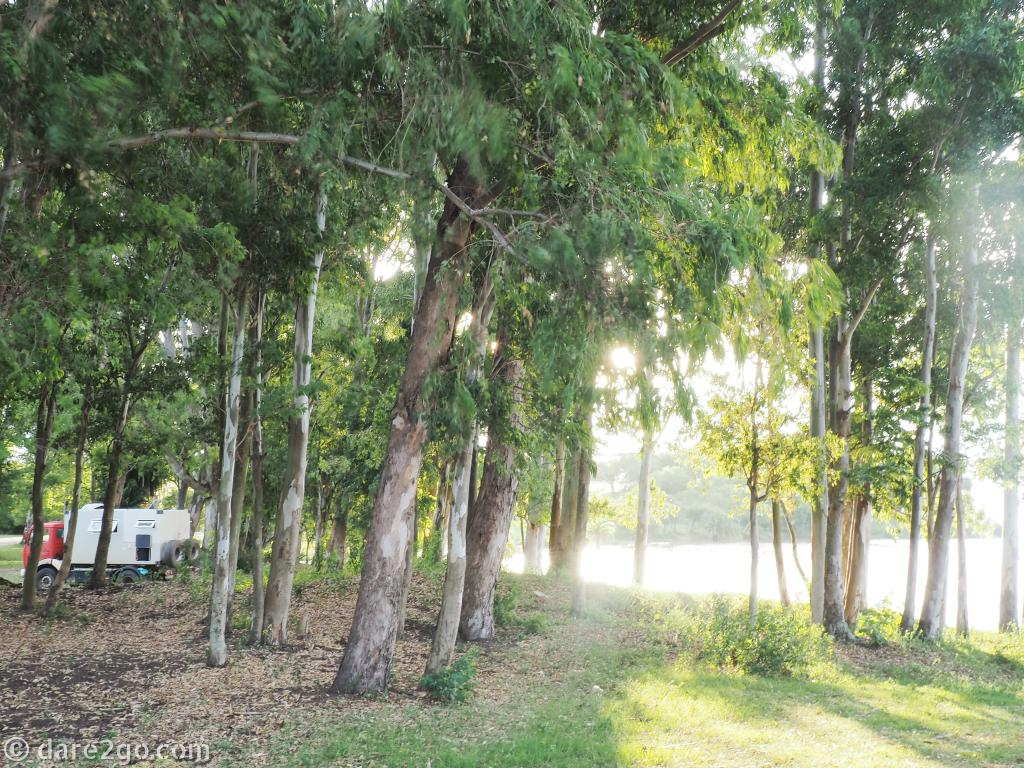
This is where we spent our first night in 2016: a large riverside park near the World Heritage listed Angus Meat Works in Uruguay.
We had signed up for a volunteering position north-east of Montevideo. It didn’t work out the way we had hoped or expected (more detail in one of our 2016 newsletters ), so we were back on the road earlier than expected. This gave us time to visit the town of 25 de Agosto, with its amazing murals – a sight you won’t find in guidebooks yet.
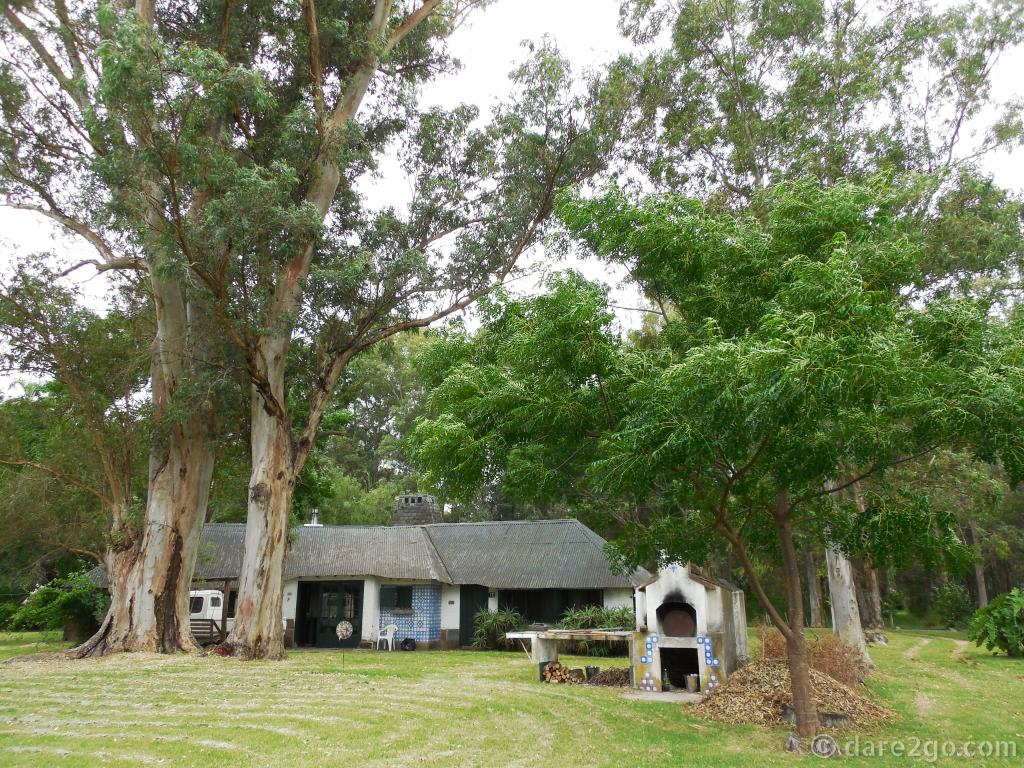
Our volunteering position in Uruguay: lots of raking of grass and dry leaves, and lots of back breaking hand-weeding.
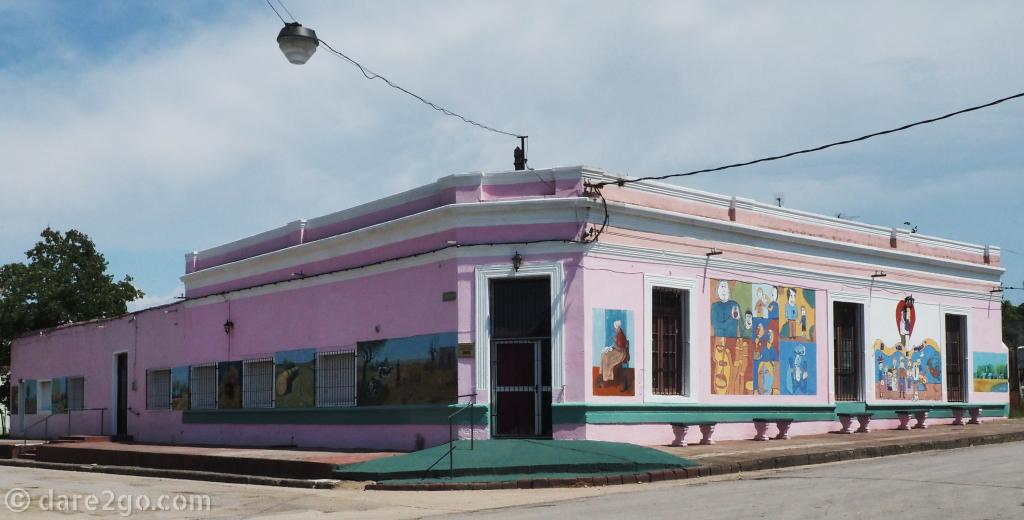
Pink corner building in 25 de Agosto with a collection of murals
February
The month of carnival – worldwide! We wanted to experience this in Montevideo as we had heard that it is quite unique. Although both of us don’t like large crowds, Las Llamadas had us spellbound . During the day we explored more of the city, visited the markets, and caught up with some website work. After carnival we travelled up the coast to visit the beaches, some of which we had last seen in 2009.
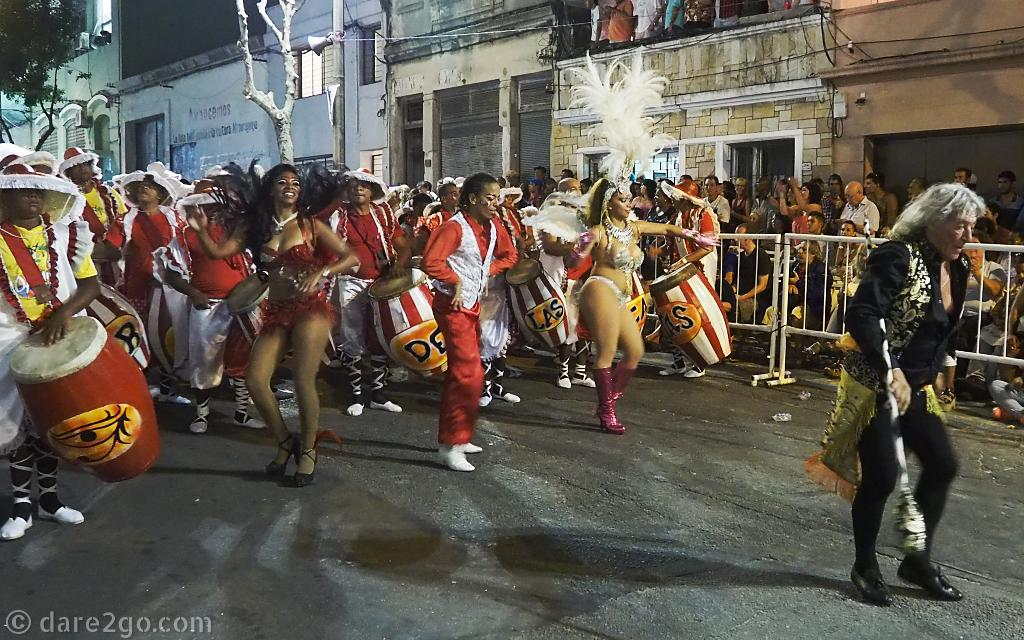
Carnival in Montevideo: a group with a grey haired El Escobillero (Broom Man) marching in front of two Vedettes and the drummers
March
In the second week of March, Uruguay celebrates its biggest Gaucho festival in Tacuarembo (German overlanders told us about this – thank you!). It was something we really wanted to see, since we had already witnessed the Gaucho culture in Argentina the year before . It also gave us the opportunity to explore more of Uruguay’s inland and to see the murals of San Gregorio .
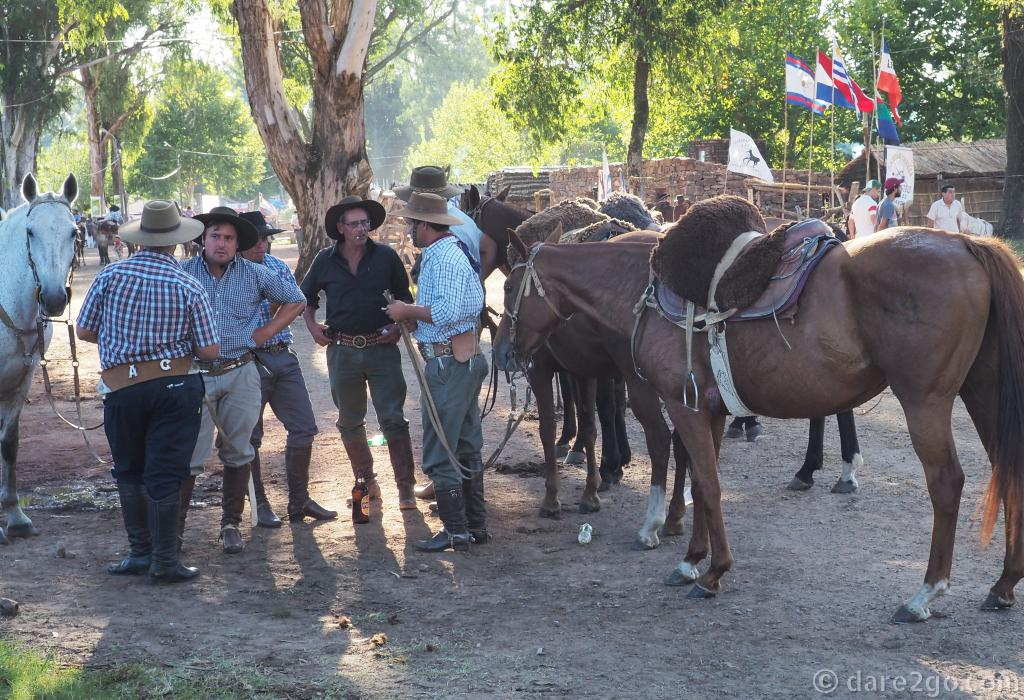
Fiesta de la Patria Gaucha: a group of gauchos waiting with their horses under shade trees for their call into the arena.

San Gregorio street art: ‘humano mamifero’, the human mammal.
We had time to ‘waste’ as we were waiting for our new credit cards to arrive by mail. Uruguay is a very easy country for overlanders : you can find a nice spot to overnight (for free) almost anywhere. It’s safe, shops offer a lot of ‘western conveniences’, and it’s very laid-back. Though one thing Uruguay is not, is cheap! But then it’s a small country, and distances are short, so you never use much fuel…
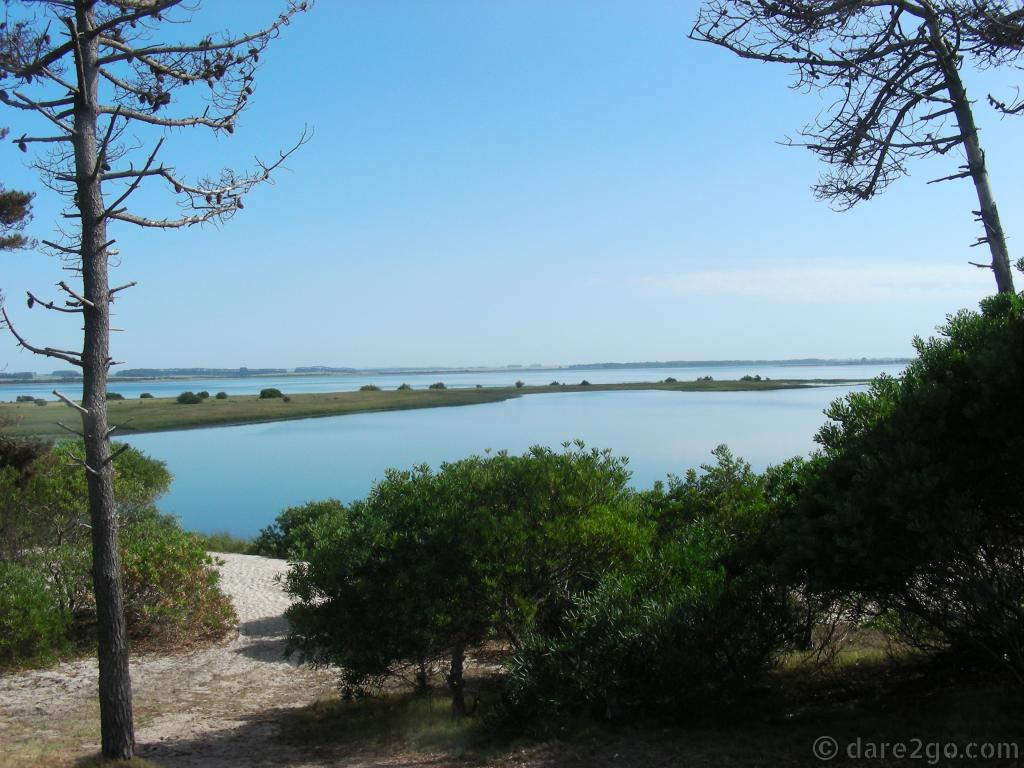
Our best beach side camping in Uruguay: across the road from the beach (which was windy with heavy salt spray) we parked in a hidden spot overlooking a tranquil lagoon.
April
On the 4th of April we arrived in Brazil; we left on the 27th of September. As we entered via Chuy we passed through Rio Grande do Sul again, a state we had explored in October the year before and also briefly in 2008. This time we had a destination: we were keen to meet up with Dani and Zander in Florianópolis. They are Brazilian overlanders we had met in La Serena/Chile the year before.
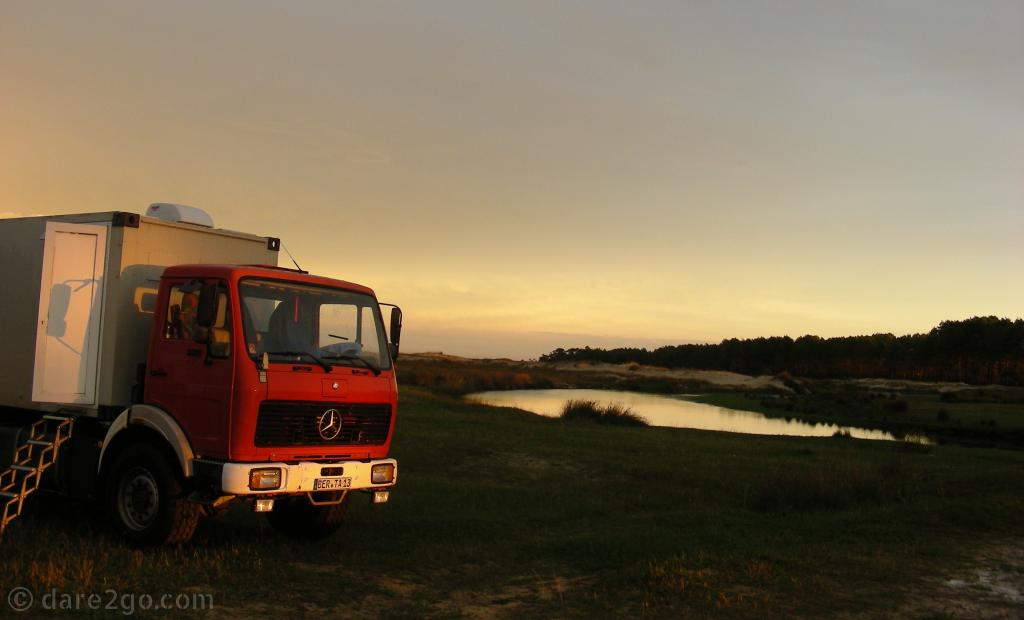
A beautiful wild camping spot in Rio Grande do Sul in Brazil. Everybody warned us about “dangerous Brazil” – we never felt threatened, and camped wild almost every night.
Along the way, I really wanted to drive a road once again, which had stuck in my mind since we drove it in 2008. Back then it was simply the shortest route to get away from the coast, which was getting busy with holiday makers. This time I learned that The Guardian lists it as one of the 10 great drives in the world: the Serra do Rio do Rastro .
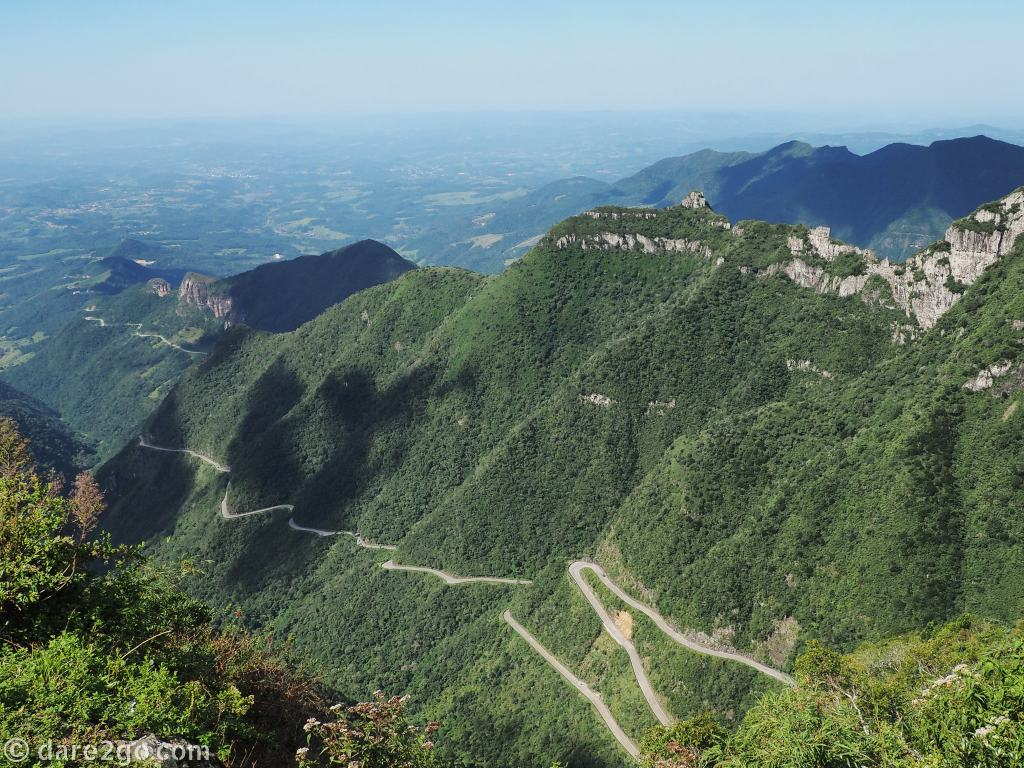
SC-390: the view from the lookout platform on top of the plateau. You can see nicely how the road disappears into the distance towards the coast. Though you don’t see many of the hairpin bends from here – for that vista you have to stop at a small viewing platform further down the mountain.
May
After leaving our friends we explored the island Florianópolis on our own . Then we went back to the mainland and drove north. We have to say that some of the first towns along the coast had changed for the worse since 2008; more built up, much more commercialised – but we know this from our home town in Australia…
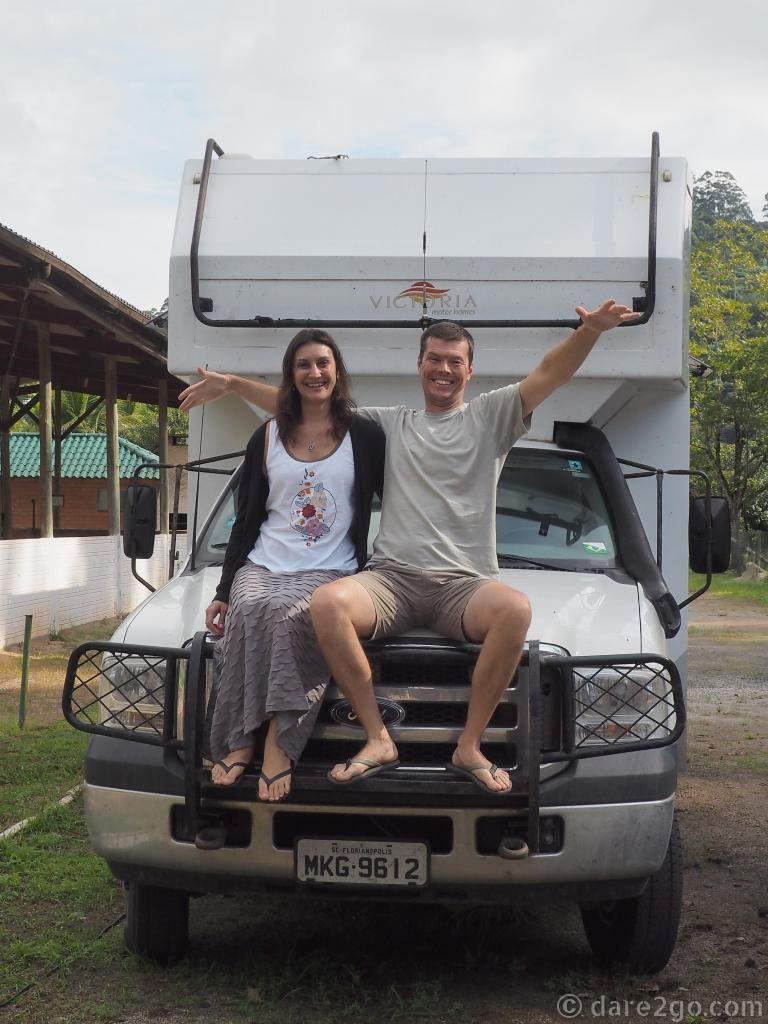
Our friends Dani and Zander. We first met them, overlanding in La Serena the year before.
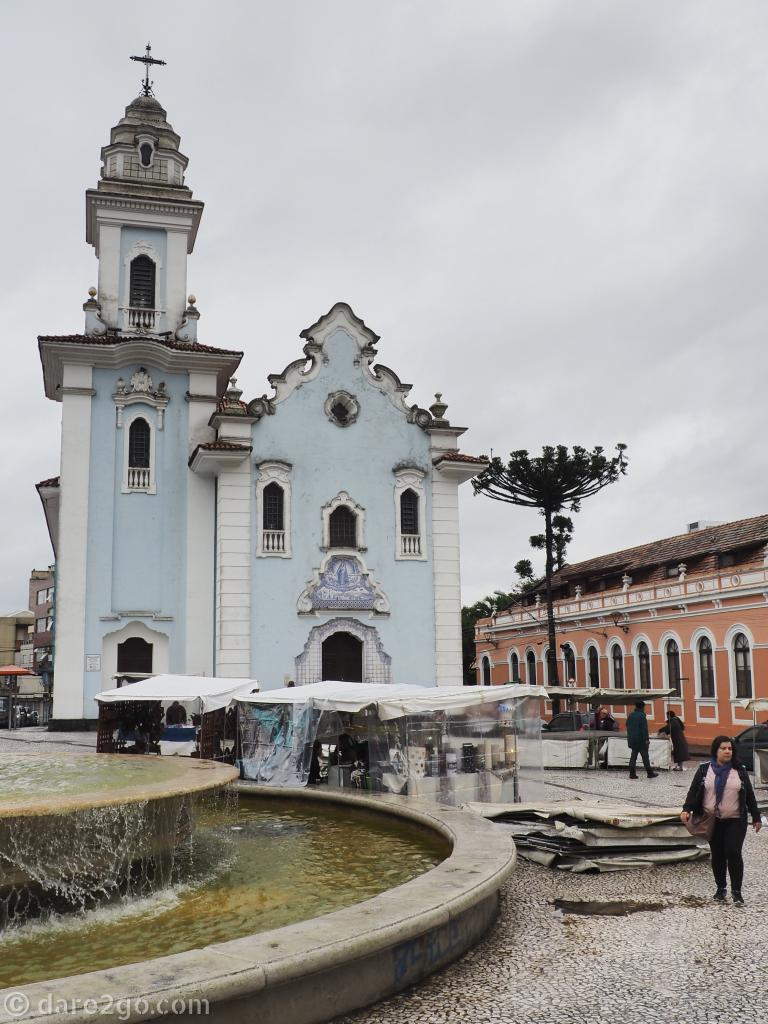
A Portuguese style church in the historic city in Curitiba.
We visited Curitiba, a city we didn’t get to see in 2008, and its amazing Oscar Niemeyer designed art centre, with the famous ‘eye’ building. Finally in Morretes, a small town we had good memories of from 2008, we found a place where things hadn’t changed that much .
June
When we crossed the border into the São Paulo state we were contacted by a couple of Brazilians with ‘parked overlander syndrome’ (their expression): Bia and Paulo from Asfalto, Terra e Mar on Instagram . We visited for a Sunday afternoon coffee and stayed for 8 days, camped in front of their house in Itamambuca near Ubatuba.
The time was characterised by shared cooking of some real feasts, a lot of storytelling and laughter, and some desperate tears, as Yasha’s father was in his last days. But it also gave us the opportunity to liberally use the internet, and stay in contact with family and friends, which was very important at such a difficult time.
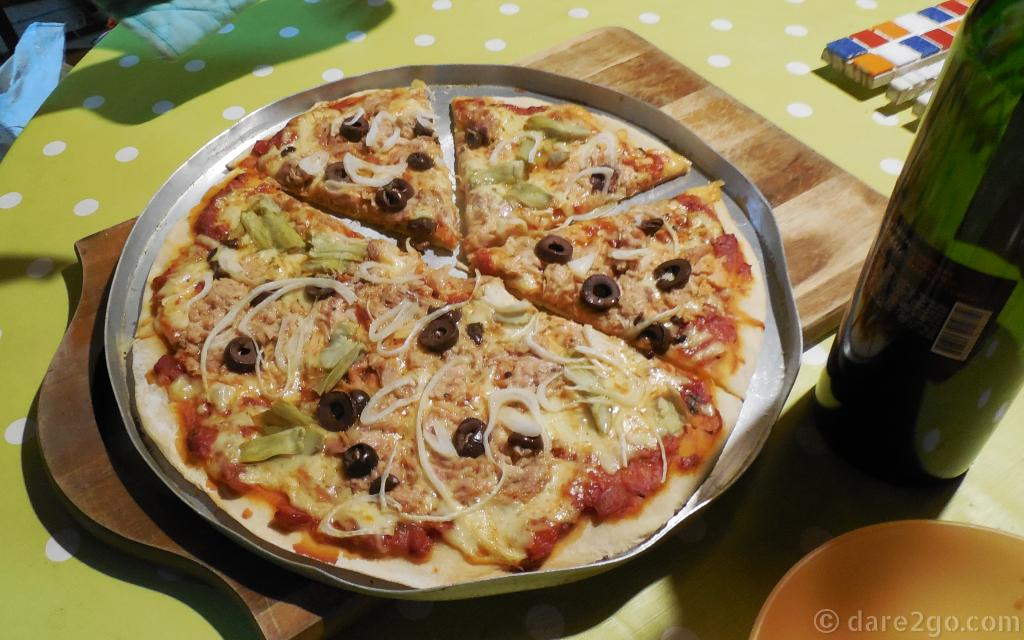
Yummy home-cooked meals and long conversations were the main focus of our stay with Bia and Paulo.
In the middle of the month we finally left. Initially we visited Paraty, the first really beautiful colonial town, which captured us this trip. We have hundreds of photos from Paraty!
Rio de Janeiro was logically the next place on our route. Since large cities aren’t really our thing we were a little apprehensive to visit – in the end it wasn’t an uplifting experience despite the fact that the city has some interesting sights.

Away from the water front in Paraty we found this small park with nice colonial buildings around it.
When we left Rio we drove across the bay to Niteroi, to see its many Oscar Niemeyer buildings . We ended the month in Buzios – another place we didn’t write much about. It’s a seaside resort made famous by Brigitte Bardot in the 60s. In many aspects it could be compared with Byron Bay, our home: the same stylish shops and restaurants, a building code which keeps development tied to a certain standard (in height and scale), and it also attracts a lot of the rich and famous.
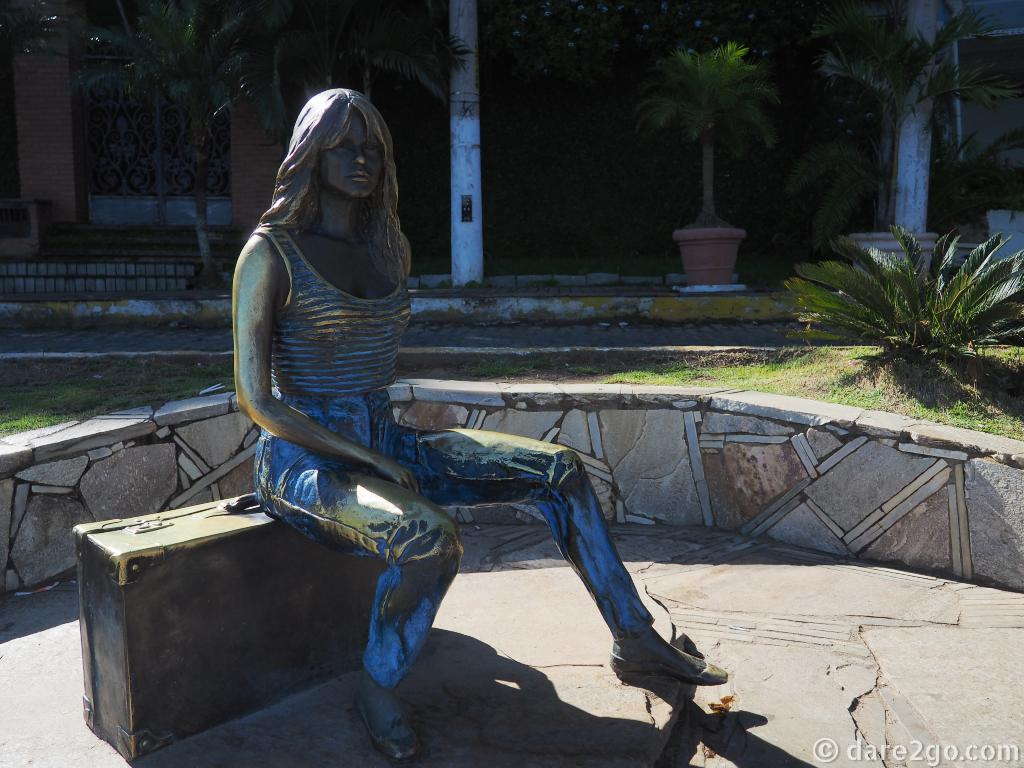
A sculpture at Búzios’ beach promenade: it was Brigit Bardot’s visit which catapulted Buziós, formerly a sleepy fishing village, into the international spotlight as a tourist destination. Now it’s also known as the Saint Tropez of Brazil.
July
During June and early July we stayed in the same sleepy little beach side town on three different occasions: Barra de São Joãa. There’s nothing really special about this town; it’s probably not really on the tourist radar, but we found a lovely parking lot on a peninsula wedged between the beach and a river mouth, where we watched the fishing boats come and go… For us, it was a perfect spot to collect our thoughts and feelings, and also get some internet work done.
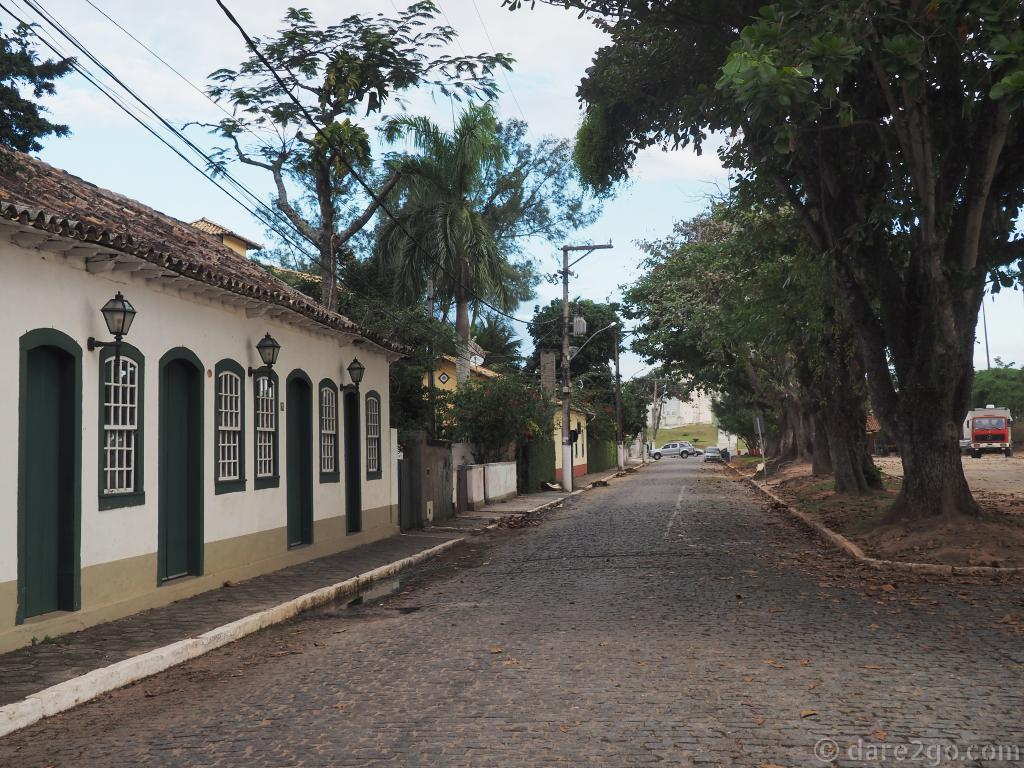
The atmosphere and some of the old houses in São João reminded of Paraty. We really enjoyed staying on this small parking lot overlooking the river.
In between, we headed inland through another part of Brazil which is strongly German and Swiss influenced. Near Nova Friburgo we even found a Swiss cheese making school (mmm – yummy cheese and chocolate on sale!). Our destination was Teresópolis and the nearby P.N. Serra dos Orgãos, a remnant of the Atlantic Forest. We stayed a few days longer to witness their annual meeting of historic cars .

At the historic Car Meeting in Teresopolis.
Later in the month we drove all the way up to the northern tip of the Espirito Santo state, a trip we only mentioned in our post ‘6 Places and Experiences we didn’t write about in 2016’ .
August
On the 1st of August we had to be back in the São Paulo state because I had an appointment for laser eye treatment in Campos dos Goytacazes. Finally, towards the middle of the month, we decided that we had to get back to some ‘serious travelling’ – we headed inland to the state of Minas Gerais.
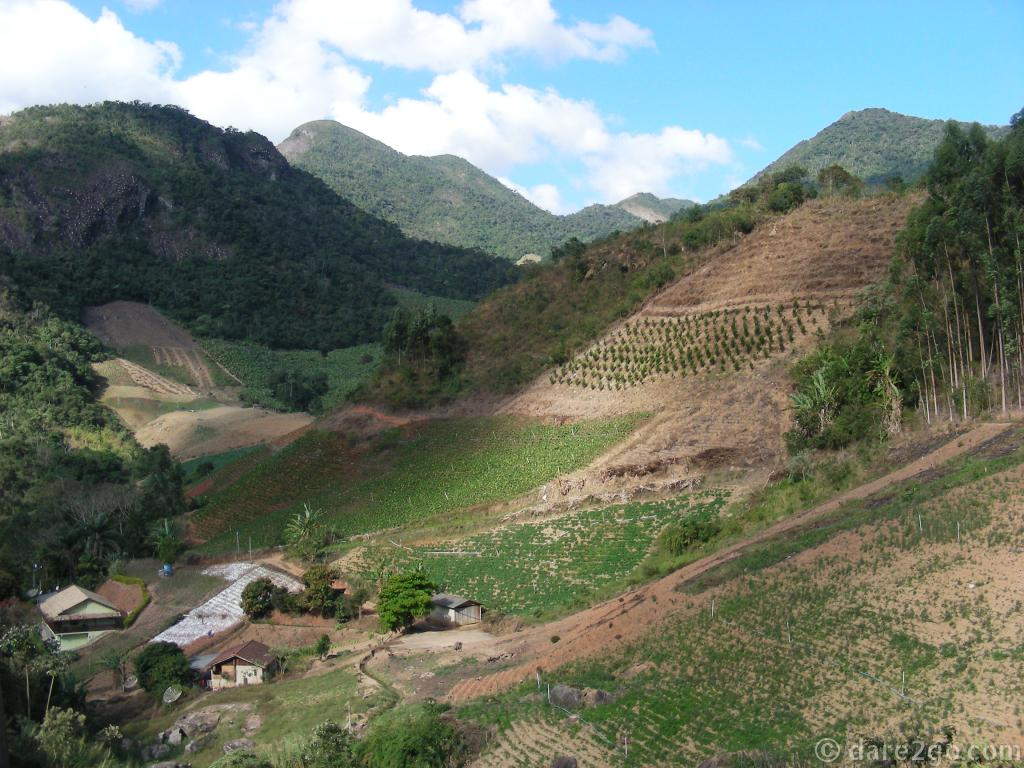
Rural landscape (note the small fields) along a small road, just before we reached Minas Gerais.
There were so many historic towns to visit, many of which are World Heritage listed , that later we thought we should have left the coast weeks earlier… Between the historic towns of Ouro Preto , Mariana, and Diamantina we also visited a completely different sight: the botanical gardens of Inhotim . To this day we really don’t know how to classify this place in two or three words. It’s so much more than a collection of rare plants – you have to experience it yourself (if possible, allow 2 days – we didn’t, and we regret it)!

Inhotim Hélio Oiticica – Magic Square #5, De Luxe: colourful squares in open space to wander through and around.
September
The month of September was characterised by some long driving days as our already extended visas were running out. The west of Brazil is more sparsely populated; the hilly landscape is dominated by dry-ish low scrub land, grain and cattle farms.
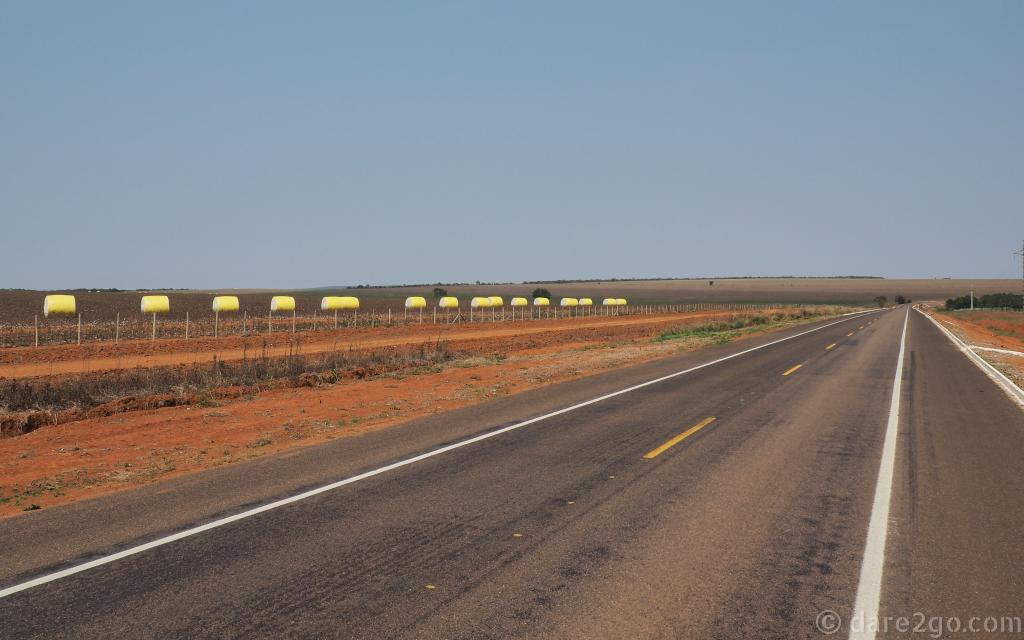
Further west into Brazil it became boring: long distances, large mono-cultures (here cotton), and an uninspiring landscape.
In between we stopped at more historical towns, some of which are also World Heritage listed . And let’s not forget our week in Brasilia! For a long time we had thought it would be too far out of the way, but in the end we were very pleased that we went and got to see all the futuristic Oscar Niemeyer buildings .
Our final destination in Brazil was the North Pantanal, the famous wetlands which are also a listed WHS. On the 27th we crossed the border with Bolivia.

We left the Pantanal just a bit disappointed.
October
Although Bolivia’s population includes many people with recent European roots, it felt very different to Brazil. Santa Cruz was the first province we came into; it is probably the wealthiest and has long aimed for independence from Bolivia. Initially it meant for us a lot of dusty dirt roads, through tropical vegetation and huge cattle farms.
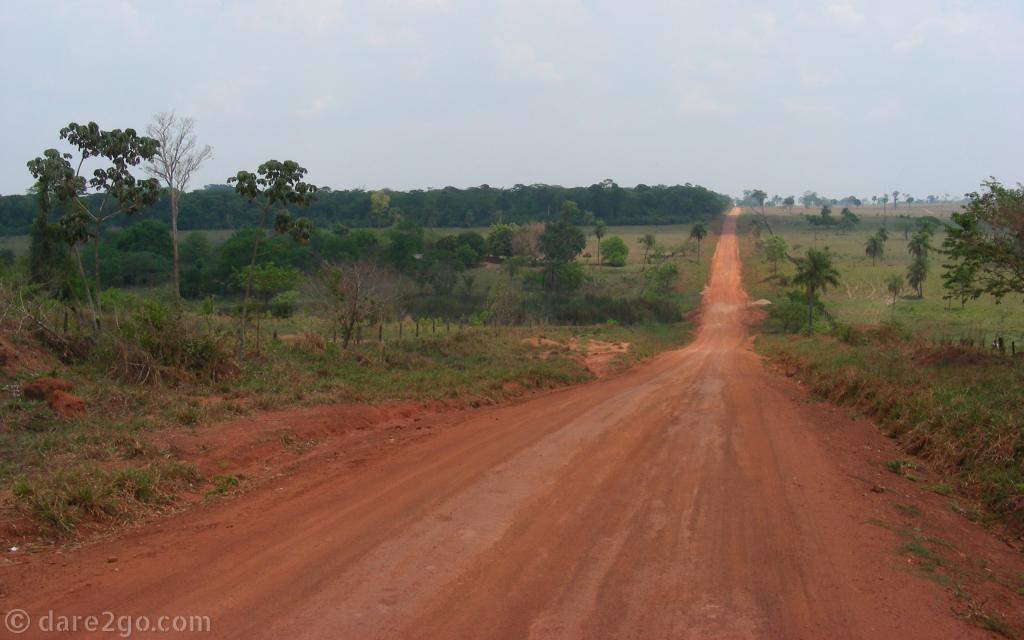
The endless cattle estancias in Bolivia were a bit boring. It made us sad to see this fertile rainforest land cleared for meat production.
One UNESCO World Heritage listing makes it really worthwhile to visit the east of Santa Cruz: the Jesuit Missions of the Chiquitos . The five (of six listed) missions we visited were the most interesting sights during our trip so far, particularly since they completed the impressions we had gained during visits to other Jesuit sites last year .
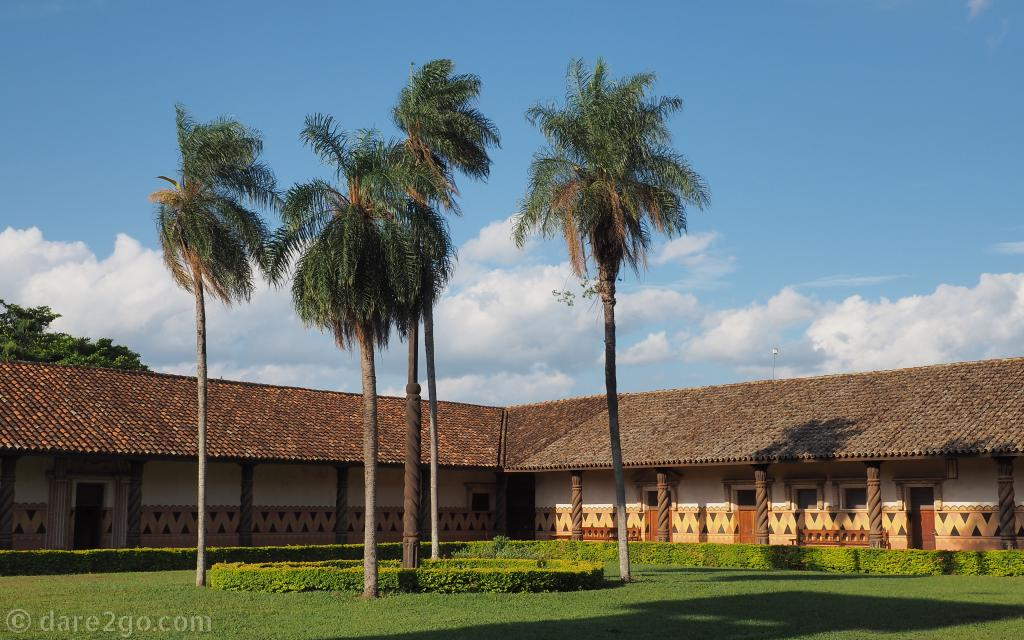
One of the stunningly restored Jesuit missions in east Bolivia.
We continued the month with three more WHS locations, which couldn’t be more different: ‘El Fuerte’ in Samaipata, the historic town of Sucre, and the mining town of Potosi. Read about these UNESCO World Heritage Sites here!
November
On the 1st of November we arrived in Uyuni, which is famous for its Salar, now a Dakar destination. By that time we had decided, for various reasons, to cut our visit to Bolivia short. We crossed the Salar de Uyuni with the intention of returning to Chile. Little did we know that the border shown on our maps was one without border facilities .
The next few weeks were spent in Iquique and Arica, waiting for our Brazilian friends Bia and Paulo to catch up with us (see June! In the meantime they had overcome their ‘parked overlander syndrome’ and had started the second leg of their trip to Alaska). This wasn’t meant to happen; the day before they would have caught up with us (for Yasha’s birthday on the 28th) their car was broken into and most of their documents stolen.
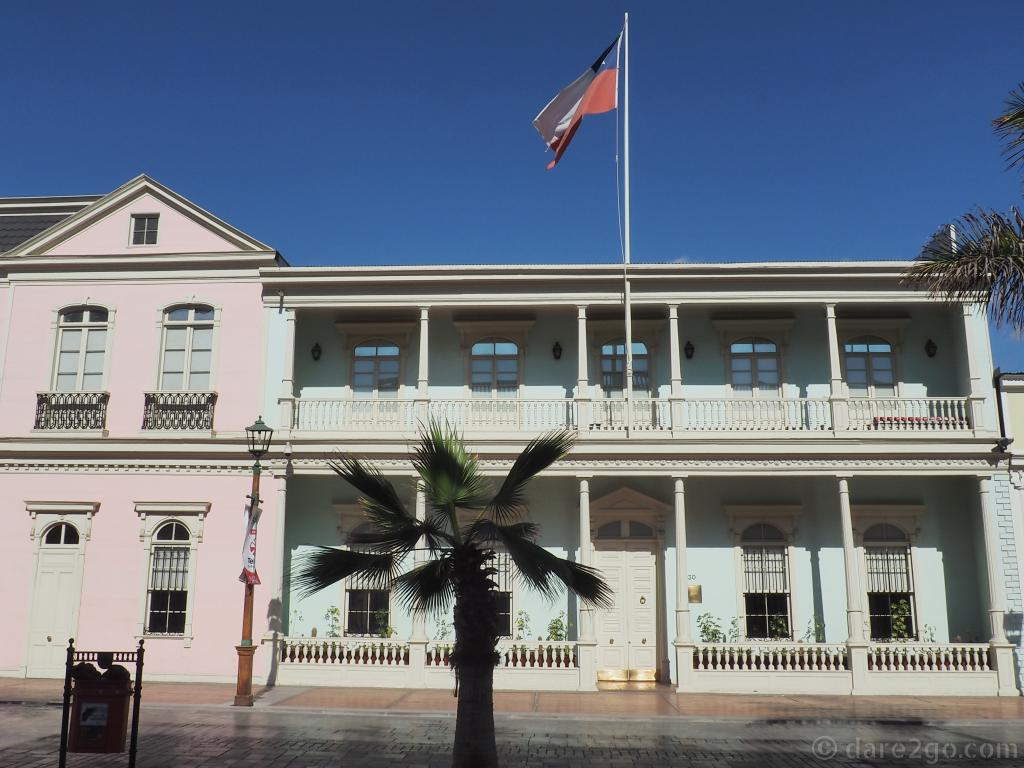
One of the old houses in Iquique; most were built during the Saltpeter boom.
We spent most of the time relaxing, sorting photos, writing some posts, and re-visiting the historic centres of both towns, Iquique and Arica. (Yasha has written a post covering our time in North Chile, which will be published soon.) On route between the two cities we also visited another WHS, the saltpeter mines of Humberstone .
December
Since we had only been waiting for our friends, we crossed the border with Peru on the 29th. This was probably one of our most bureaucratic border crossings this trip… The first town in Peru, Tacna, is a medical destination for Chileans: dozens of dentists next to dozens of glasses shop; I had some cheap prescription reading glasses made within 2 hours…
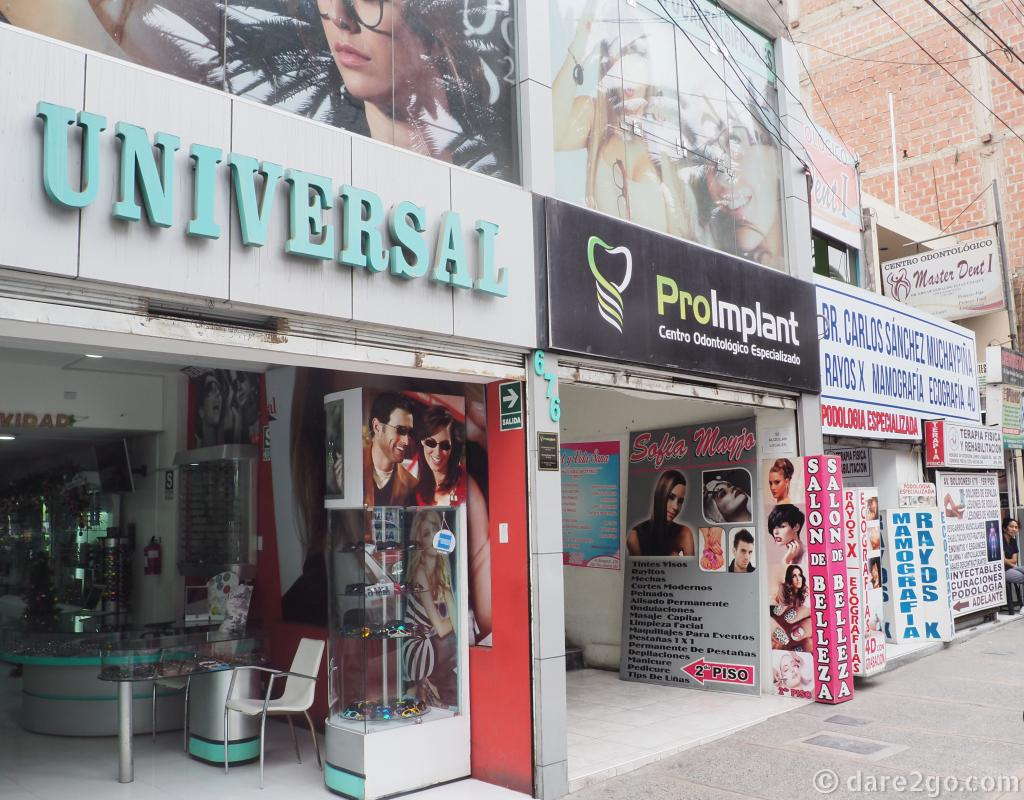
Tacna seems to live mostly off medical tourism; Chileans come for cheap dental treatments and new glasses.
We travelled along the barren coast until it was time to turn inland to Arequipa. There our Brazilian friends finally caught up with us. To this day we haven’t written anything about our December in Peru – we will update this page once it’s done.
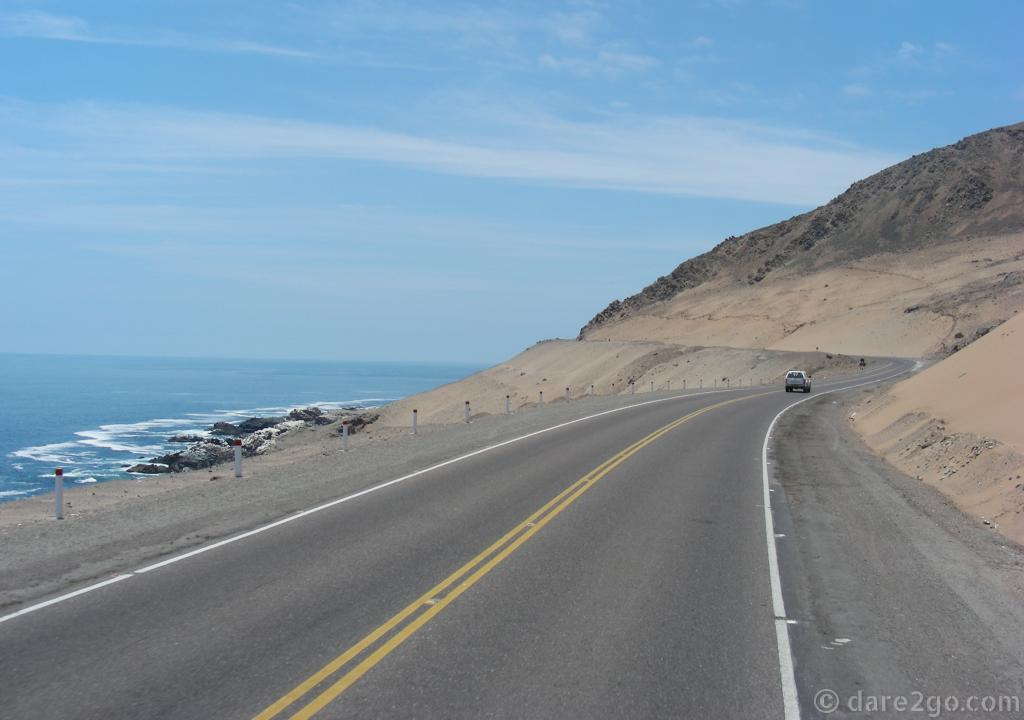
The coastal road in southern Peru: clear blue water, often steep cliffs, and inland nothing but sandy desert.
And what will 2017 bring?
Later in the year we’ll reach Ecuador, where Yasha quietly hopes to find a job teaching English in Cuenca, or some other lovely spot to spend some time. If not we might reach Colombia before year’s end and possibly ship back to Europe…

PIN THIS for later!
- Pinterest10
- Facebook18
- Twitter4
- Reddit0
- Flipboard0
- Email0
- Buffer7
- 39shares
- Like
- Digg
- Del
- Tumblr
- VKontakte
- Buffer
- Love This
- Odnoklassniki
- Meneame
- Blogger
- Amazon
- Yahoo Mail
- Gmail
- AOL
- Newsvine
- HackerNews
- Evernote
- MySpace
- Mail.ru
- Viadeo
- Line
- Comments
- Yummly
- SMS
- Viber
- Telegram
- Subscribe
- Skype
- Facebook Messenger
- Kakao
- LiveJournal
- Yammer
- Edgar
- Fintel
- Mix
- Instapaper
- Copy Link



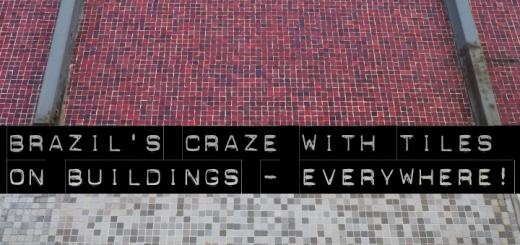


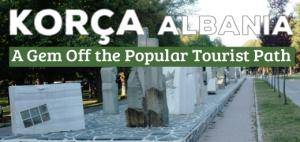






I am enjoying your blog, it is great some positive comments about my homeland of Brazil. So glad that you have enjoyed your time there. I have recently visited your home country and absolutely loved it😄
We loved Brazil, Gilda, especially the people. They were very friendly and welcoming. But you have some great places there to see as well. I’m glad you liked Australia and I’ll be checking out what you did while you were there.
For years I steered clear of South America, but in the the past two years I have had the opportunity to visit Ecuador, Chile and Argentina. I have considered Brazil since, and your post and glorious photos are leaning me even more toward Brazil!! All the best in 2017!!
Glad that we can inspire people like you to consider new destinations. For a short itinerary please see my reply above (to Donna Janke’s comment).
Looks like a great year with varied experiences. I’ve not travelled to South America at all, but your posts have really piqued my interest.
Donna, if you’re interested to get a taste of Brazil, then I recommend Paraty, the beaches around Paraty (or Ilha Grande), and the colonial towns of Minas Gerais (plus the botanical gardens of Inhotim, which is en route). In those parts we felt the safest. All have a strong tourist infrastructure, Paraty has a large expat community (often the hotel owners), and you could probably find pre-arranged tours starting in Rio de Janeiro or São Paulo (cheaper to fly to). Just avoid peak summer (December to mid February), best time to visit is the Brazilian spring (from mid August onwards). Without too much stress this could be a nice vacation for 2 weeks or bit longer.
I had never heard the term “overlanders” before… :) Sounds like you are enjoying your adventures in Brazil and haven’t found the country to be a dangerous one to travel through. If you have had positive experiences with the people you have met on your travels, I think that makes all the difference. Happy travels in 2017!
Thank you, Debra!
From all we hear we might have missed the most dangerous part of Brazil: the far north. But then again: this might be exaggerated too… Travel experiences are always unique and very subjective.
Wow, you guys are courageous. We are also slow travellers, but to do it overland and in South America takes guts. Congratulations!
Some fantastic photos, the Serro do Rio de Rasto is quite something.
Frank (bbqboy)
Actually, it’s not as gutsy as many people (who haven’t done it) might think. The vast majority of people are really friendly and helpful. Maybe even more so than in ‘western’ societies. There are a few hot spots for crime, but nothing worse than in gang riddled cities of the USA. This is our second trip and we are still enjoying it.
David and I have been to Argentina, Uruguay and Chile more than once but never Brazil. We have always been a bit nervous of the safety aspect there but maybe one day we’ll pluck up the courage.
Brazil is really weird in a way. The locals watch all the time reports about gang crimes in the ‘favelas’ and often warned us that overlanding is really dangerous. Yet, if you asked questions which go a deeper, like has ever something happened to you personally, your family or friends, you often get to hear ‘no’, but of course we’re careful. I guess it’s like travelling in the USA or even in Sydney: you avoid certain parts of a city and are careful where you go.
On the other hand we haven’t met as many friendly and inviting people elsewhere (well, maybe in Colombia, another country many people are still afraid to visit); the Brazilians are really warm and welcoming people!
We hear and read more about petty theft against overlanders in Chile than in Brazil. Like our Brazilian friends, who were robbed in Iquique – twice within 24 hours! They never experienced something like that in Brazil…